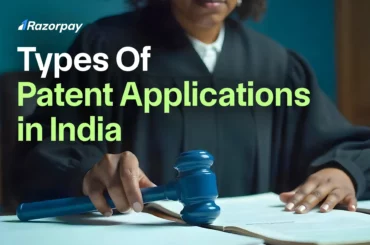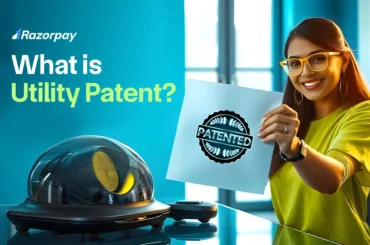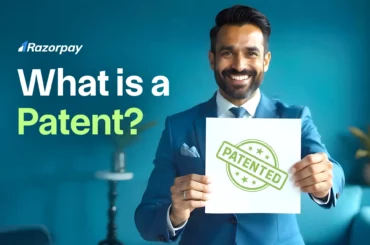Intellectual property (IP) refers to creations of the mind, like inventions, brands, and artistic works. Protecting it is crucial to prevent misuse and ensure creators benefit from their work. Patents protect inventions, copyrights safeguard creative works like art and literature, and trademarks defend brand names and logos. Each legal tool secures a different aspect to protect various types of intellectual creations.
Hence, it is crucial to understand the difference between copyright and patent, as well as trademark.
Table of Contents
The Difference Between Patent, Copyright and Trademark
|
Aspect |
Patent |
Copyright |
Trademark |
|
Protection For |
Inventions and processes |
Original works of authorship |
Brand names, logos, and slogans |
|
Duration |
Generally 20 years |
Life of the author, or afterwards through family or estate for 60 more years |
Indefinitely (as long as in use) |
|
Registration |
Required for protection |
Automatic upon creation, but registration is beneficial |
Required for legal protection |
|
Rights Granted |
Exclusive rights to use, sell, and licence the invention |
Exclusive rights to reproduce, distribute, and display the work |
Exclusive rights to use the mark in commerce |
|
Examples |
New technologies, pharmaceuticals |
Books, music, films, software |
Razorpay and its logo |
|
Legal Tool |
Patent law |
Copyright law |
Trademark law |
What Is a Patent?
A patent is an intellectual property protection tool that is granted as a legal right by a government authority to an inventor or creator. It grants them legal right to their invention or creation for a specified period, generally 20 years. The main purpose of a patent is to stop others from benefitting monetarily or socially by using their inventions and creations.
The Office of the Controller General of Patents, Designs and Trade Marks (CGPDTM) grants patents to individuals and entities as per the patent laws in India. The patent granting agency in the US is the United States Patent and Trademark Office (USPTO), while in the EU, it is the European Patent Office (EPO). However, the inventor must provide a detailed disclosure of the invention to the patent office. This includes clearly describing how the invention works, its technical specifications, and any potential applications.
Types of Patents
1. Utility Patent
A utility patent covers new or improved products, processes, or machines. This type of patent is the most common and protects the functional aspects of an invention, such as how it works or is used. Utility patents typically last up to 20 years from the filing date, but inventors must pay maintenance fees regularly to keep the patent in force. Examples of utility patents include software algorithms, chemical formulas, and innovative manufacturing processes.
2. Plant Patent
A plant patent protects new plant varieties that can be reproduced asexually, meaning they can be propagated without seeds and not tuber propagated. This type of patent is granted for up to 20 years, and no maintenance fees are required. Notable examples of plant patents include the ‘Honeycrisp’ apple and the ‘Knock Out’ rose, both of which have been patented for their unique traits and characteristics.
3. Design Patent
Design Patent covers a manufactured item’s unique appearance or ornamental design rather than its function. Hence, they are also defined as the “surface ornamentation” of a product or object, including its configuration and shape. In India, Design Patents are registered initially for ten years from the initial registration date. However, if the patent office has allowed a claim to priority, the duration is ten years from the date of priority. Examples of design patents include the distinctive shape of the Coca-Cola bottle and the iPhone’s design.
Related Read: 4 Types of Patents: How to Choose the Right Patent
What is a Copyright?
Copyright is a legal protection granted to original works of authorship, such as books, music, films, art, and software. This protection gives creators exclusive rights to reproduce, distribute, and publicly display their works, allowing them to control how their creations are used and to benefit financially from them.
Copyright protection generally begins automatically after an original work is created, given that the curator must have evidence claiming its originality. Although it is not required to register for a copyright, it is always beneficial to do so for heightened legal protection in case of disputes.
The copyright duration is generally 60 years in India in terms of artistic, dramatic, literacy, and musical work. In case the identity of the author is disclosed before the said period of 60 years is over, then the copyright subsists until 60 years following the next calendar year in which the author dies. However, this excludes the “fair use” doctrine, where limited use of copyrighted material is allowed without permission for purposes such as criticism, comment, news reporting, teaching, or research.
Examples of previously copyrighted works in India include:
“Gitanjali” by Rabindranath Tagore
“Sholay” movie by Ramesh Sippy
“Malgudi Days” by R.K Narayan
“Train to Pakistan” by Khushwant Singh
What is a Trademark?
A trademark is a legal protection for words, symbols, logos, or designs that identify and differentiate one entity’s goods or services from others. Trademarks help consumers recognise the source of products, ensuring they receive quality goods that are authentic and produced by the preferred entity.
Trademarks are slightly different from service marks based on what they protect. While Trademarks are used to protect and identify goods, service marks are used to protect and identify services.
Avoiding the “likelihood of confusion” is crucial when creating a trademark, as it can lead to disputes. The “likelihood of confusion” factor entails that you must extensively research a new trademark before it is created to avoid the possibility of it closely resembling or infringing on existing trademarks.
Examples of well-known Trademarks include the McDonald’s logo, the US Polo Association (USPA) emblem and Razorpay’s logo. These trademarks play a vital role in brand recognition and consumer trust.
What is a Trade Secret?
A trade secret is any confidential business information that is critical for the business to have an edge over its competitors. It is highly important for a business as it forms the base for its operations and distinguishes its products and services from others. This can include formulas, practices, processes, designs, instruments, or compilations of information that are not generally known or easily accessible.
Businesses generally implement non-disclosure agreements (NDAs), restrict access to sensitive information, information regulations, strict chain of command and utilise security protocols to ensure that trade secrets remain confidential.
Why Patent, Copyright, and Trademark are Important?
Patents, copyrights, and trademarks are essential tools in protecting intellectual property. They safeguard innovations, creative works, and brand identity, ensuring creators and businesses benefit from their efforts and maintain a competitive edge.
Patent
Patents protect inventions by granting exclusive rights to the inventor for a set period. This prevents others from making, using, or selling the invention without permission, allowing the inventor to benefit financially and control how the innovation is used or distributed.
Copyrights
Copyrights safeguard original creative works such as literature, music, and art. They provide authors with exclusive rights to reproduce, distribute, and perform their work. This legal protection ensures that creators can monetise and control the use of their creations.
Trademarks
Trademarks protect brand identity, including logos, symbols, and names. They help businesses maintain authenticity and reputation by preventing others from using similar marks, which could confuse consumers. Trademarks play a crucial role in establishing trust in the marketplace.
How Do You Apply For Patents, Copyrights, and Trademarks?
Trademarks
- Choosing a trademark: The brand or mark name you choose must be unique and should belong to any or multiple 45 classes of goods and services specified for registering a trademark. Classes 1-34 are for registering trademarks for goods, while the remaining are for services.
- Mark search: Conduct a trademark search on the website of the Controller General of Patents, Designs and Trademarks to ensure that the mark you have chosen is unique and does not closely resemble any existing trademark.
- Filing application: You can apply for a trademark in India for one or multiple goods and services classes, you need to complete the TM-A form. If you are not an individual, small enterprise, or startup, you need to choose the ₹9,000 or ₹10,000 bracket. On the other hand, if you are one of the three entities, you need to select the ₹4,500 and ₹5,000 bracket.
- Documents: You will need to submit documents such as the Business Registration Proof (if not individual), a soft copy of the trademark, proof of claim, and power of attorney.
- Verification: Once you have filed the trademark application online or offline, the Registrar of Trademarks will verify your application, and if there is no opposition, your brand name will be published in the Indian trademark journal, completing the trademark registration. You will also receive a trademark certificate.
Copyright
- Application submission: You need to apply online or offline to the Copyright Office. The template for the form may vary depending on the type of work you are trying to get a copyright for, such as art, music, or literacy.
- Document submission: You will need to submit some documents to complete the application process. These include the copy of work, power of attorney and demand draft of the fee if filed physically or through an authorised agent.
- Review: Once you submit the application, the Copyright Office reviews the form and documents to ensure there are no objections.
- Registration: After successful verification or resolving objections, the Copyright Office registers the work and grants the copyright. It issues a registration certificate with all the details about the registration entered into the Registrar of Copyrights.
Patent
- Non-disclosure agreement: The process of how to apply for a patent in India includes a non-disclosure agreement. You need to disclose the invention to the registering professional by signing a non-disclosure agreement.
- Patent search: The professional execute extensive research to ensure that your patent does not resemble any existing patent and builds a patentability search report. Here, you may need to pay the charges levied by the professional for the search.
- Filing application: Once you have created the patent draft, you can apply manually or with the help of a professional. You need to file the application in the prescribed manner with relevant forms and pay the set fees, ranging between ₹1,600-₹1,800. The application must be filed online or submitted to the patent office.
- Examination request: Within 48 hours of applying, you must request the patent office for examination by paying the examination request fee. The fee may range between ₹4,000-₹20,000.
- Objections: You must respond to any objections raised within the prescribed time. If there are no objections, this step is automatically skipped.
- Patent grant: The patent office will grant you the patent after verifying your application. It is generally granted by notifying through a published journal.
Conclusion
Protecting intellectual property through patents, trademarks, and copyrights fosters innovation, creativity, and economic growth. Patents, copyrights and trademarks are important intellectual protection tools. Patents safeguard inventions, granting inventors exclusive rights to their creations; trademarks help establish brand identity and prevent consumer confusion; and copyrights protect creators’ artistic and literary works, ensuring they can benefit from their efforts.
Hence, individuals and businesses must evaluate their specific needs and consider which form of intellectual property protection best aligns with their goals. By doing so, they can secure their innovations and contributions, promoting a vibrant and competitive marketplace. Now that you know the difference between copyright, trademark and patent, you can better protect your intellectual properties.
Frequently Asked Questions (FAQs)
1. Patents copyrights and trademarks are which assets?
Patents, copyrights, and trademarks are types of intellectual property assets. They provide legal protections for inventions, creative works, and brand identifiers, allowing their owners to control and benefit from their use.
2. What Is Included in a Trademark?
A trademark includes words, symbols, logos, or designs that identify and distinguish the source of goods or services. This protection helps consumers recognise the brand and prevents confusion with similar marks.
3. What is the Difference Between Trademark, Patent, and Copyright with Example?
A trademark protects brand identifiers (e.g., the Nike Air Jordans), a patent protects inventions or processes (e.g., a new type of engine), and a copyright protects original works (e.g., a novel like “Harry Potter”).
4. Is a Trademark Better Than a Patent?
Whether a trademark is better than a patent depends on a business’s specific needs. Trademarks offer indefinite protection as long as they are in use, while patents provide exclusive rights for a limited period but can cover new inventions.
5. How Long Does It Take to Get a Patent?
The time it takes to obtain a patent can vary widely but generally ranges from 3-6 years, depending on the invention’s complexity and the patent office’s workload.
6. Can Trademarks Expire?
Yes, trademarks can expire if they are not renewed or if they are not used in commerce for a specified period. Regular maintenance and renewal are necessary to keep a trademark active.
7. Can a Work Be Protected by Both Copyright and Trademark?
Yes, a work can be protected by both copyright and trademark. For example, a logo for a book series can be trademarked while the book’s text is protected by copyright.
8. How Do I Know If My Invention Is Patentable?
It must be novel, provide utility, non-obvious, and not have previously been disclosed to the general public.




